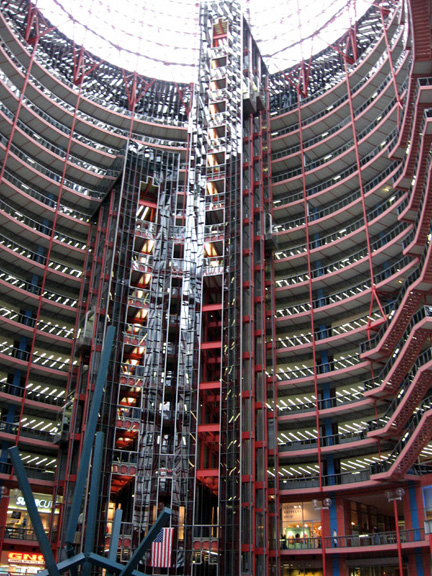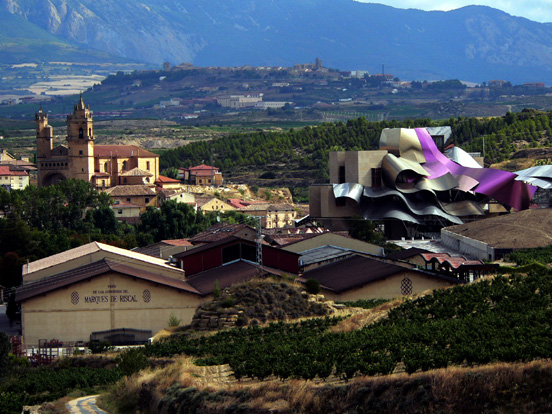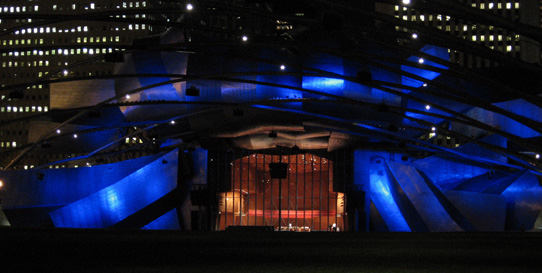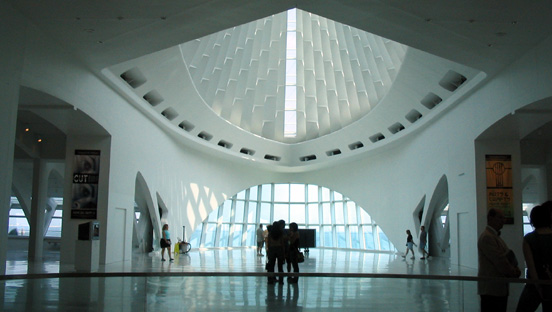Repeat- Writings on Architecture: The Age of Bilbao (original) (raw)
ArchitectureChicagoPlus correspondent, architect Iker Gil, reminds us that today is the ten year anniversary of one of the most pivotal dates in architectural history: the October 19th, 1997 opening of Frank Gehry's Guggenheim Museum in Bilbao, Spain. It was the day "The Bilbao Effect" drove the final spike through the heart of Post-Modernism, and the age of the Techno-Baroque was born.
The marriage of technology and modern architecture isn't exactly new, but it's traditional pedigree was much more constrained. Here's a prime example, Helmut Jahn's 1985 State of Illinois Building . . .
Beautiful, to be sure, but with a hard, aggressive edge.Gehry rebelled against this putting Descartes before the horse. and - perfectly timed for a new gilded age of the internet bubble - unashamedly celebrated beauty for its own sake, form liberated from function, Robert Venturi's decorated shed in splenderific apotheosis.
Architecture fled the minimalist monastery and booked a pool suite at Sybaris. In the Swinging 60's, modernism had been ascetic; in the decade of 9-11 and dark secrets, it became sensual, even hedonistic. Gehry fled cold Canada for sunny Southern California, and found a nurturing canvas in Spain, where the Baroque had mingled piety and ecstasy in unashamed alliance.
You can see it here, in a photo by Iker Gil, of Gehry's 2006 Hotel Marques de Riscal in Elciego. To the left, the 16th Century Iglesia de San Andr�s. To the right, Gehry's techno-Baroque hotel, reinventing the aesthetic for the 21st century, a rivulet of color cascading down its spine as purple as the grapes of the local wineries.  To the left, the old church-dominated Europe, where wine was the transubstantiated blood of Christ; to the right, the increasingly secular Europe of today, where it's the lubricant of international tourism.
To the left, the old church-dominated Europe, where wine was the transubstantiated blood of Christ; to the right, the increasingly secular Europe of today, where it's the lubricant of international tourism.
Recently certified by a guest shot on The Simpsons, Frank Gehry has become the public personification of "architect", and his designs of "architecture", just like Frank Lloyd Wright half a century before. His billowing, shimmering metallic forms have become a trademark as recognizable as the Apple logo or Nike swoosh. The architect's initial model for the Pritzker Pavilion in Chicago's Millennium Park was rejected because it wasn't "Frank Gehry" enough, a mistake he wouldn't repeat in the final design, a spectacular lion's-mane proscenium executed in scalloping metal, an arched trellis soaring above the lawn before it as a brawny yet delicate web of pipe-metal threads framing stage and skyline alike.
Gehry is sui generis, but his influence can be felt in many of the most iconic buildings of our time, from Will Alsop's Sharp Centre in Toronto, to Santiago Calatrava's art museum in Milwaukee . . . 
and transit hub in Manhattan . . .  to Krueck and Sexton's sculpted glass facade, diamond cut, for the soon-to-open home for the Spertus Institute . . .
to Krueck and Sexton's sculpted glass facade, diamond cut, for the soon-to-open home for the Spertus Institute . . .  . . . to a hundred other examples I'm sure come quickly to your mind. Divergent in sensibilities and aesthetic principles, they still carry the stamp of the freedoms Gehry's Bilbao proclaimed.
. . . to a hundred other examples I'm sure come quickly to your mind. Divergent in sensibilities and aesthetic principles, they still carry the stamp of the freedoms Gehry's Bilbao proclaimed.
The Puritan in me protests: Are we having a bit too much fun? Can the sublime really be found in hotels and shopping malls, in crumpled up sheets of shiny metal? Have we become kittens mesmerized by string, distraction's addicts?
Yet, through the testimony of the senses, Gehry keeps making the case for the centrality of delight, for pulses quickened by pleasure and a heightened experience of being alive. Discuss among yourselves but, to paraphrase a former American President, "We're all Bilbaoans now."
Add your comments on this story here.
© Copyright 2007 Lynn Becker All rights reserved.